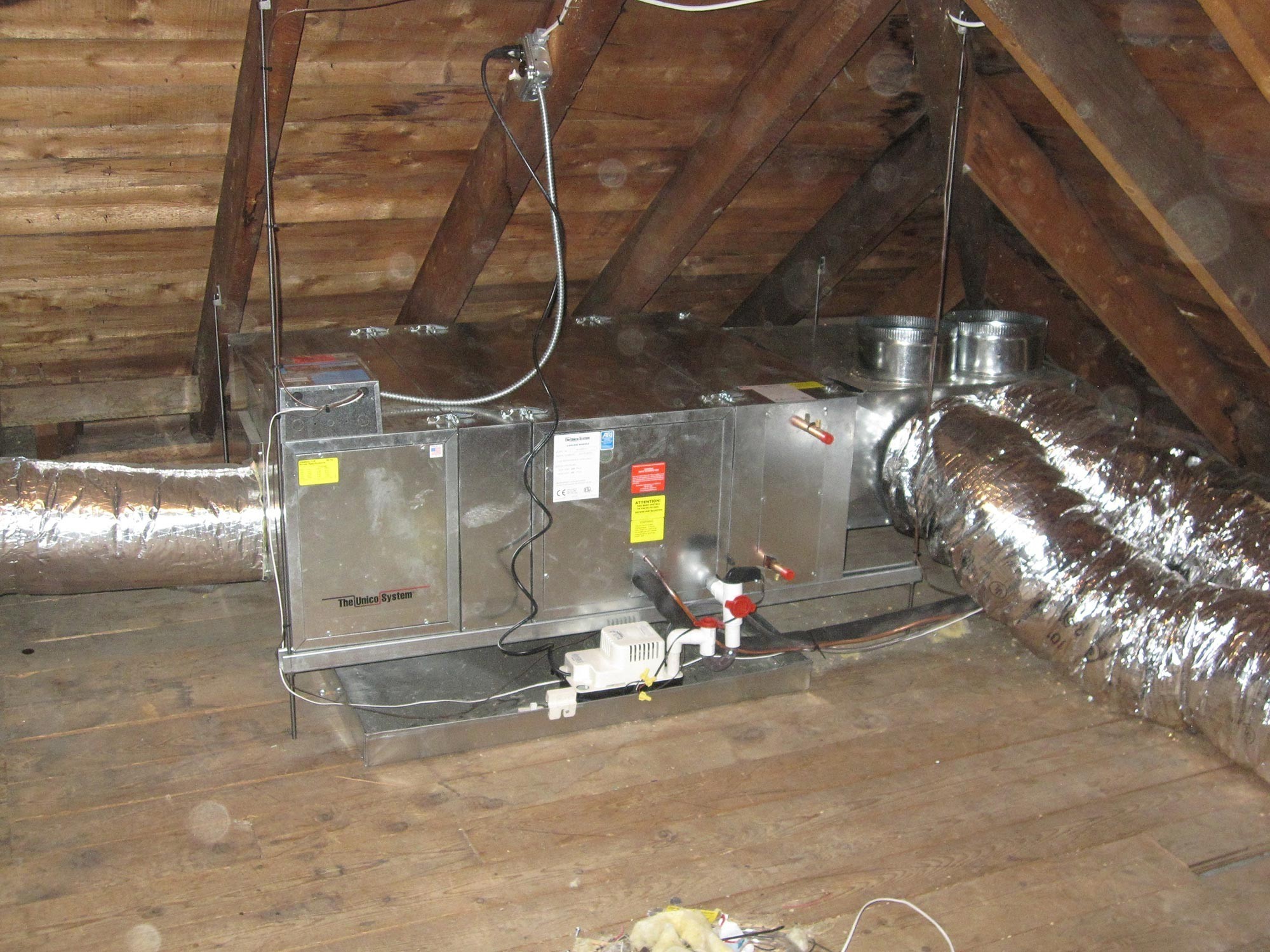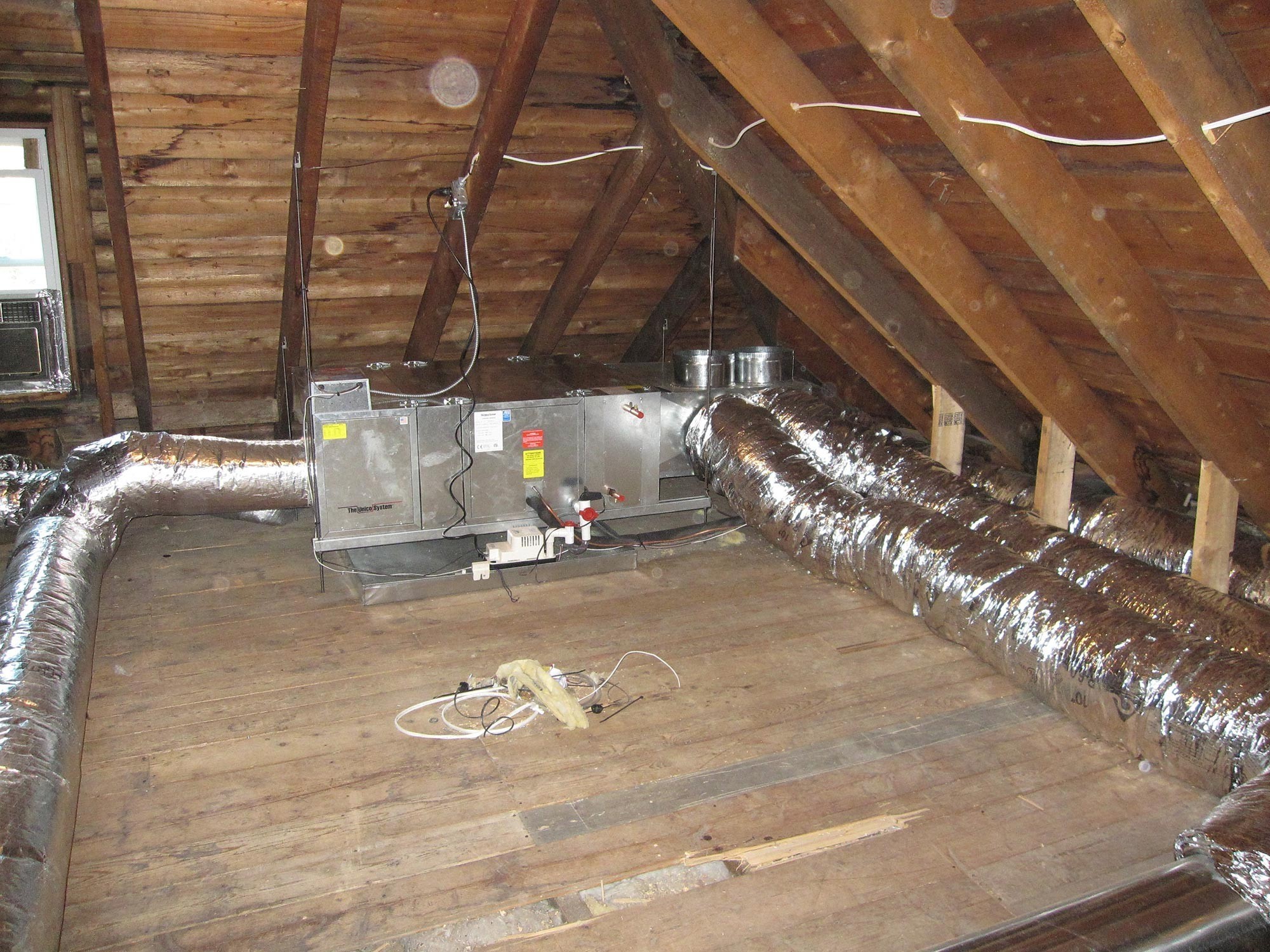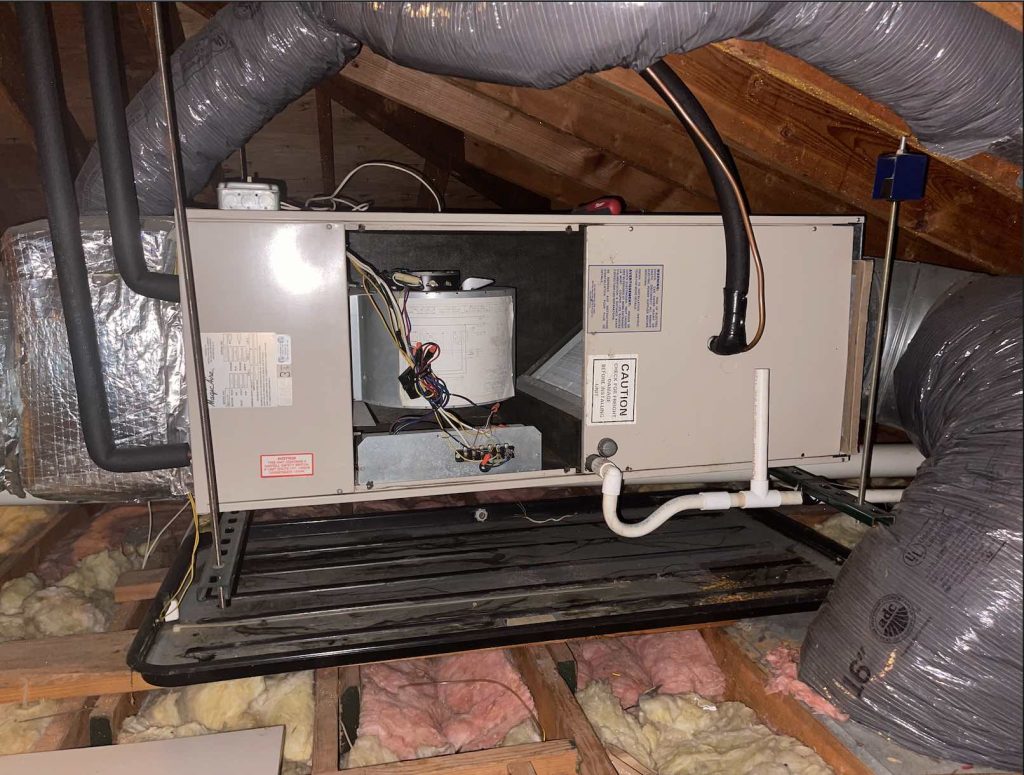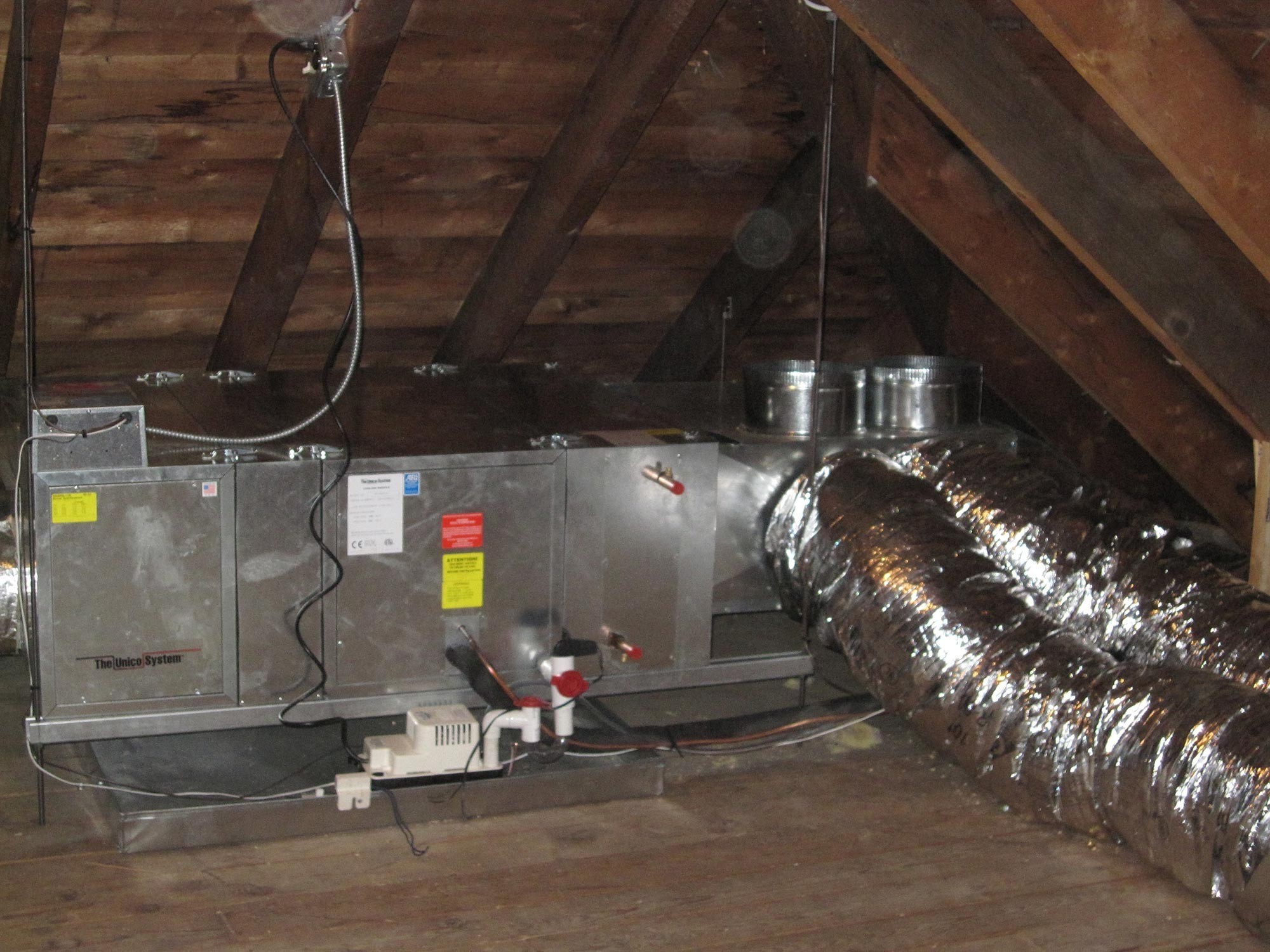Heat Pump Air Handler In Attic
The HVAC industry is constantly evolving, demanding professionals who are knowledgeable and adaptable. A crucial component in modern heating and cooling systems is the heat pump air handler, and its installation in attics presents unique considerations. This article explores the nuances of heat pump air handlers in attic environments, providing insights for students, technicians, and employers.
Understanding Heat Pump Air Handlers
A heat pump air handler is an indoor unit that works in conjunction with an outdoor heat pump unit to provide both heating and cooling. Unlike traditional furnaces that generate heat, heat pumps transfer heat from one location to another. In cooling mode, they extract heat from inside a building and expel it outside. In heating mode, they reverse the process, drawing heat from the outside air (even in cold temperatures) and transferring it indoors. The air handler circulates this conditioned air throughout the building via ductwork.
Key Components of an Air Handler:
- Blower Motor: Circulates air.
- Coils (Evaporator/Cooling Coil & Heating Coil): Facilitate heat transfer.
- Air Filter: Removes dust and pollutants.
- Expansion Valve or Metering Device: Regulates refrigerant flow.
- Control Board: Manages the system's operation.
- Drain Pan: Collects condensation.
Why Install a Heat Pump Air Handler in the Attic?
Attic installations are common, particularly in regions with limited space or when retrofitting existing homes. Here are some reasons for choosing an attic location:
- Space Savings: Frees up valuable living space.
- Retrofit Convenience: Easier to integrate into existing homes without major structural changes.
- Cost-Effectiveness (Potentially): Can sometimes be less expensive than other installation locations, depending on existing ductwork.
Challenges of Attic Installations
However, attic installations come with their own set of challenges:
- Extreme Temperatures: Attics are subject to significant temperature fluctuations, which can impact system efficiency and longevity.
- Accessibility: Maintenance and repairs can be difficult due to limited space and access.
- Insulation Requirements: Adequate insulation is crucial to prevent heat loss or gain, ensuring optimal performance.
- Condensation Issues: Properly managing condensation is essential to prevent water damage and mold growth.
- Air Leakage: Ductwork in attics is prone to air leakage, reducing efficiency and increasing energy costs.
Best Practices for Attic Heat Pump Air Handler Installations
To mitigate the challenges, HVAC professionals must adhere to best practices:
- Proper Insulation: Insulate the air handler and ductwork to the highest recommended R-value for the climate zone.
- Air Sealing: Thoroughly seal all ductwork connections to prevent air leakage. Use mastic sealant and metal tape, not duct tape.
- Condensate Management: Ensure proper slope and drainage of the condensate line. Consider installing a condensate pump and safety switch to prevent overflows.
- Accessibility: Provide adequate access for maintenance and repairs. Install a platform or walkway if necessary.
- Ventilation: Ensure proper attic ventilation to reduce moisture buildup and temperature extremes.
- Emergency Shutoff: Install an easily accessible emergency shutoff switch near the attic entrance.
- Professional Sizing and Selection: Correctly sizing the unit for the home's heating and cooling load is critical. A Manual J calculation should be performed.
Career Paths and Certification
Working with heat pump air handlers, especially in challenging environments like attics, requires specialized skills and knowledge. Here's a look at relevant career paths and certifications:
Entry-Level Positions
HVAC students and apprentices typically start as installers or service technicians. They assist experienced technicians with installations, maintenance, and repairs. A strong understanding of HVAC fundamentals, electrical wiring, and safety procedures is essential.
Experienced Technicians
Experienced technicians can specialize in heat pump systems. This requires advanced troubleshooting skills, knowledge of refrigerant handling, and the ability to diagnose and repair complex issues. Continuing education and professional development are crucial for staying up-to-date with the latest technologies.
Potential Career Paths
- HVAC Installer: Installs new systems, including heat pumps and air handlers.
- HVAC Service Technician: Diagnoses and repairs existing HVAC systems.
- HVAC Maintenance Technician: Performs routine maintenance on HVAC systems.
- HVAC Design Engineer: Designs HVAC systems for new construction and retrofits.
- HVAC Sales Engineer: Sells HVAC equipment and services to customers.
Essential Certifications
- EPA Section 608 Certification: Required for handling refrigerants. This certification demonstrates compliance with federal regulations and ensures responsible refrigerant management.
- NATE (North American Technician Excellence): A widely recognized certification that validates a technician's knowledge and skills. NATE offers certifications in various specialties, including heat pumps. Obtaining NATE certification can significantly enhance career prospects and earning potential.
- HVAC Excellence: Another reputable certification organization that provides competency-based assessments for HVAC technicians.
- State and Local Licenses: Many states and municipalities require HVAC technicians to be licensed. Requirements vary by location, so it's essential to check local regulations.
Salary Expectations: According to the U.S. Bureau of Labor Statistics, the median annual wage for HVAC mechanics and installers was $51,390 in May 2021. The highest 10 percent earned more than $81,690. Salary ranges vary depending on experience, location, and certifications. Technicians with specialized skills and certifications, such as NATE certification, typically earn higher salaries.
Job Outlook
The job outlook for HVAC mechanics and installers is projected to grow 5 percent from 2021 to 2031, about average for all occupations. The demand for energy-efficient heating and cooling systems, including heat pumps, is expected to drive job growth. As building codes become stricter and consumers seek to reduce their energy consumption, the demand for skilled HVAC technicians will continue to increase.
Employer Considerations
For employers in the HVAC industry, hiring and retaining skilled technicians is essential for success. Here are some key considerations:
- Recruitment: Actively recruit from trade schools and apprenticeship programs. Offer competitive salaries and benefits to attract top talent.
- Training: Provide ongoing training and professional development opportunities to keep technicians up-to-date with the latest technologies and best practices. Invest in training programs that cover heat pump systems, including air handler installation and maintenance.
- Certification Support: Encourage technicians to pursue certifications, such as NATE and EPA Section 608. Offer financial assistance or incentives to support certification efforts.
- Safety: Prioritize safety by providing technicians with proper safety equipment and training. Ensure that technicians follow all safety procedures when working in attics and other challenging environments.
- Technology: Equip technicians with the latest tools and technology to improve efficiency and accuracy. This includes diagnostic equipment, refrigerant recovery machines, and software for system sizing and design.
"Investing in skilled technicians is an investment in the future of your business. By providing training, certification support, and a safe working environment, you can attract and retain top talent, ensuring the long-term success of your company." - HVAC Industry Analyst
The Future of Heat Pump Technology
Heat pump technology is constantly evolving, with advancements in efficiency, performance, and refrigerant technology. As concerns about climate change and energy consumption continue to grow, heat pumps are becoming an increasingly popular choice for heating and cooling. HVAC professionals who are knowledgeable about heat pump systems will be in high demand in the years to come.
Emerging Trends:
- Variable Speed Compressors: Offer improved efficiency and comfort by adjusting the heating and cooling output to match the actual demand.
- Smart Thermostats: Allow homeowners to control their HVAC systems remotely and optimize energy consumption.
- Refrigerant Alternatives: The industry is transitioning to refrigerants with lower global warming potential (GWP) to reduce the environmental impact of HVAC systems.
- Integrated Systems: Heat pumps are increasingly being integrated with other renewable energy technologies, such as solar panels, to create highly efficient and sustainable energy systems.
In conclusion, understanding heat pump air handlers, especially in the context of attic installations, is crucial for HVAC professionals. By mastering the technical aspects, obtaining relevant certifications, and staying up-to-date with industry trends, technicians can advance their careers and contribute to a more sustainable future. Employers who invest in their workforce and embrace new technologies will be well-positioned to succeed in the evolving HVAC industry.









